Spying on our great white sharks
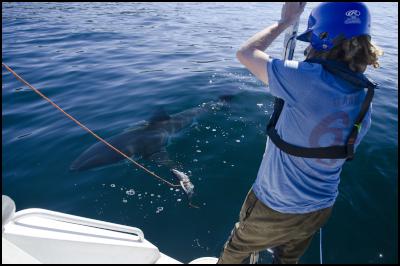
Kina Scollay shark tagging. Credit: NIWA
NIWA Media Release
Embargoed
until 11 April 2012
Spying on our great white sharks
Scientists have just completed a successful trip to Stewart Island, tagging 23 great white sharks. The sharks were tagged with acoustic and popup tags, and filmed underwater for photo-identification purposes. The tags and photos will allow scientists to investigate the sharks’ habitat and behaviour, and to determine the periods during which they inhabit locations such as Stewart Island.
NIWA Principal Scientist Dr Malcolm Francis says, “We saw many of the same sharks that we have tagged in the same place in previous years. Some of them are local identities that have become well known to us. We saw a 4.1 metre male called Marbletail, named after the colour pattern on his tail. He was seen on most days at Edwards Island, our main tagging site. After we had tagged him, he became a nuisance by dominating the other sharks and scaring them away. It became much harder to tag new sharks as the trip went on.”
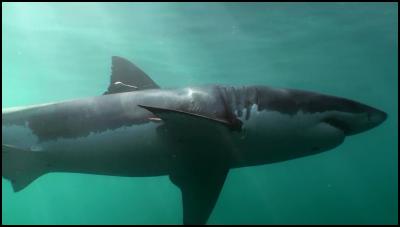
Marbletail with PAT tag, Edwards Is, 16 March 2012. Credit: Clinton Duffy, DOC.
The National Institute of Water and Atmospheric Research (NIWA), Department of Conservation (DOC), and University of Auckland scientists are investigating whether the sharks are residents or transient at these locations, and the size of the population inhabiting New Zealand. They want to learn more about where sharks go, and when, in an effort to reduce the chances of sharks being accidentally caught in set nets and on lines.
To work out where sharks go, the scientists must first tag them. The sharks are attracted to the boat with a berley of tuna oil and minced tuna. When the shark is close enough, a long pole is used to stab the tag into the shark, injecting it under the skin, in the muscle below the dorsal fin. That part of the shark is only exposed for a short time as it swims by.
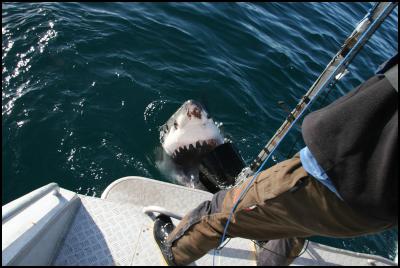
Phred biting underwater camera. Credit: Chris Mace, NIWA.
Tagging is a well-coordinated team event. Underwater cameraman Kina Scollay takes video for photo-identification, while the scientists try to entice the sharks close come close to the boat with the tuna bait. The tagger waits for the shark’s back to be exposed below the dorsal fin and close enough to tag.
“The tagger has to focus intensely on that part of the shark, and decide in a split second when to attempt the tagging. If he is slightly too early or too late, there is a danger that the tag will not end up in the right place. The team has become much more skilful at doing this after several years of tagging,” says Dr Francis.
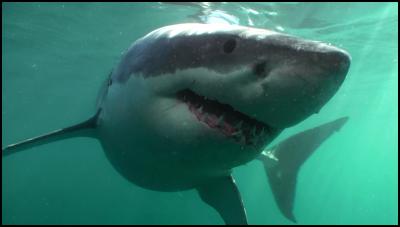
Red-yellow-red 3.6m male, Edwards_Is, 16 March 2012. Credit: Clinton Duffy, DOC
Pop-up tags stay on the shark for a predetermined time and record depth, location, and temperature, so they are useful for tracking shark movements to the tropics and back. After about a year the tag “pops up” and transmits data to the scientists’ email inbox via satellite.
On this trip, acoustic tags were also used as these provide information on a smaller scale, showing where sharks go to within a few hundred metres. The acoustic tags send out a coded pinging sound that is unique to every shark.
Data loggers can record when each shark is present by detecting their pings. The data loggers have a range of about 500 m, and 17 of these were deployed on moorings around northeastern Stewart Island and Ruapuke Island. The tags’ batteries last for two years, and the data loggers will be left in the water for that duration. The data will be downloaded from the data loggers at 3–6 month intervals.
The scientists say that the pieces of the puzzle are coming together.
“We have an exciting dataset that tells us where each shark was and when,” says DOC scientist Clinton Duffy.
“Last year’s tagging showed that all of the sharks tagged in March 2011 left Stewart Island by mid-June to mid-July 2011. From New Zealand, they then make journeys of more than 2500 km to tropical islands north of New Zealand. Because of their tropical migratory behaviour, we anticipate that we will continue to get a lot of hits on the loggers during autumn and early winter, with not much happening over late winter to summer while the sharks are away in the tropics.”
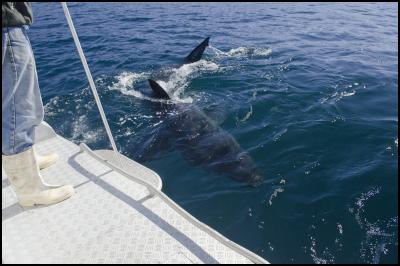
Shark Tagging. Credit: NIWA.
Smile! You’re on camera.
The
scientists are building a unique picture of each shark.
Photos were taken of at least 30 different white sharks,
most of which were also tagged.
“Great white sharks
are individually recognisable from their colour pattern,
particularly around their gills and on the tail, and the
pattern of notches on the trailing edges of their dorsal
fins” said Mr Duffy.
“By building up a photo catalogue of known individuals, we can start to understand which sharks return each year to Stewart Island, and which ones are new arrivals. By comparing the numbers of known sharks with the numbers of new sharks, we can estimate the population size in the region. Last year we estimated that around 100 sharks were in the region at some time over the previous three years. Once we have gone through all our footage and identified and counted each shark, we will be able to refine that estimate, but so far it looks like it will be higher than last year’s estimate.”
NIWA’s research is funded by the Ministry of Science and Innovation (MSI).
Dr Malcolm Francis will be giving a public
talk, at Science in the City, at the Cloud, on Thursday 12
April, at 2.30pm. The media and the public are welcome to
attend the lecture and public open day.
The event will include dynamic displays of CRIs’ and other science organisations' work as well as talks by inspirational scientists about their work:
10:00 am The Hauraki
Gulf
12:00 pm Antarctica
2:30 pm
Great white sharks
ENDS


 NZ Trucking Association: TruckSafe New Zealand Launches | A Game-Changer For Heavy Vehicle Safety And Compliance
NZ Trucking Association: TruckSafe New Zealand Launches | A Game-Changer For Heavy Vehicle Safety And Compliance Gaurav Mittal, IMI: How Can We Balance AI’s Potential And Ethical Challenges?
Gaurav Mittal, IMI: How Can We Balance AI’s Potential And Ethical Challenges? Science Media Centre: Several US-based Environmental Science Databases To Be Taken Down – Expert Reaction
Science Media Centre: Several US-based Environmental Science Databases To Be Taken Down – Expert Reaction Consumer NZ: Despite Low Confidence In Government Efforts, People Want Urgent Action To Lower Grocery Bills
Consumer NZ: Despite Low Confidence In Government Efforts, People Want Urgent Action To Lower Grocery Bills NZ Banking Association: Banks Step Up Customer Scam Protections And Compensation
NZ Banking Association: Banks Step Up Customer Scam Protections And Compensation The Reserve Bank of New Zealand: CoFR Seeking Feedback On Access To Basic Transaction Accounts
The Reserve Bank of New Zealand: CoFR Seeking Feedback On Access To Basic Transaction Accounts



